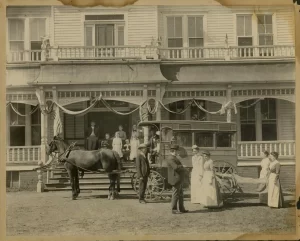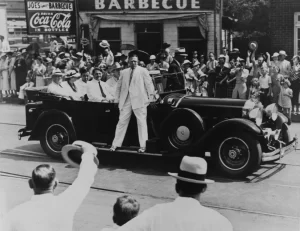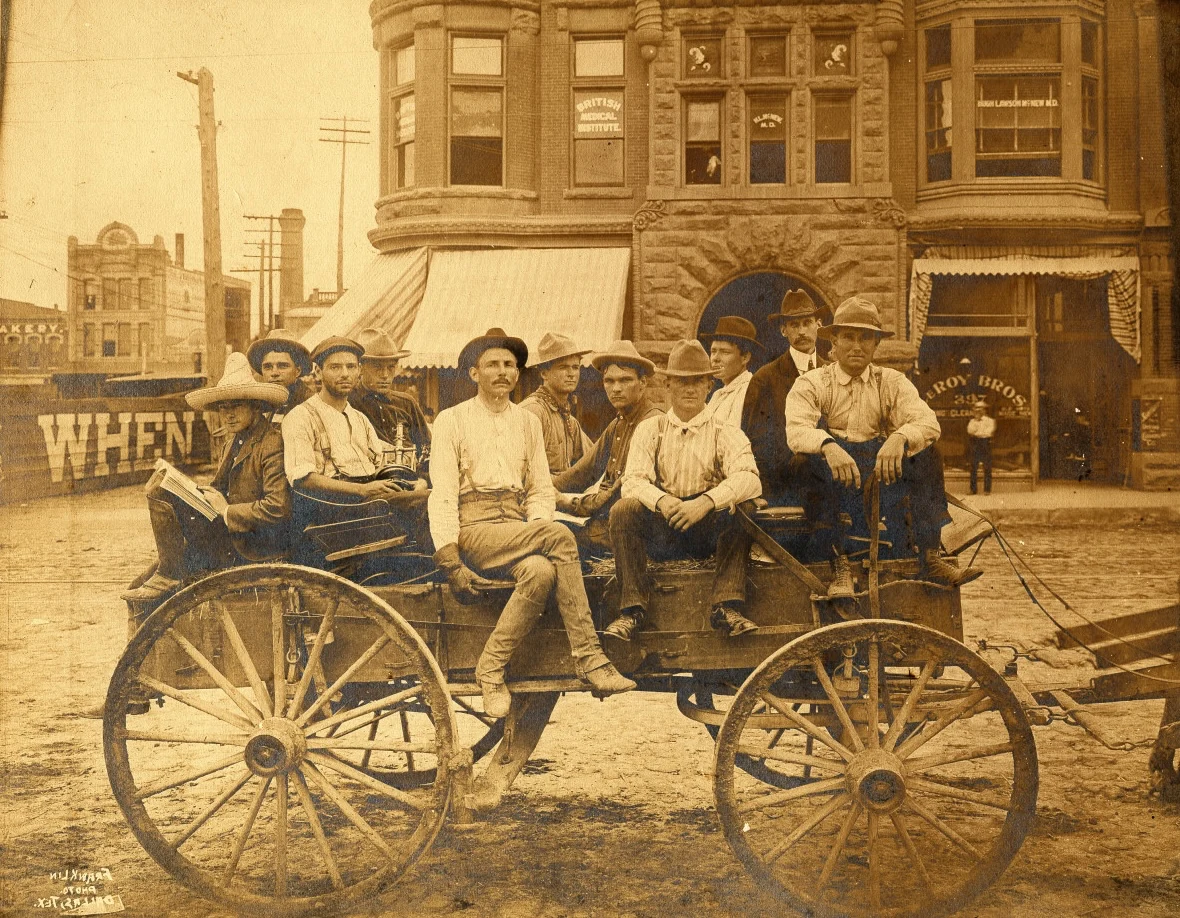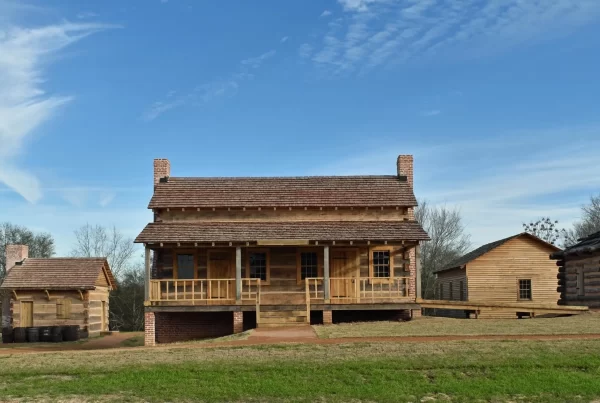Introduction
Dallas’s modern identity as a corporate center and political powerhouse is rooted in a century of steady, deliberate economic growth. Founded in 1841 as a modest trading post on the Trinity River, the city evolved into the cotton capital of North Texas, a regional banking hub, and a center for manufacturing and distribution.
Its first hundred years — from the Republic of Texas era through World War II — saw Dallas transformed by agriculture, transportation, finance, and industry. Business leaders worked closely with state lawmakers to secure infrastructure, regulate markets, and shape policies that supported growth. Yet the city’s political landscape in these years was far from monolithic. It encompassed pro-business conservatives, Progressive reformers, and New Deal Democrats who all contributed to Dallas’s civic development.
Organized here by industry rather than chronology, this history shows how Dallas built the economic foundations that later supported its emergence as both a corporate hub and a focal point in Texas politics.
Agriculture and the Cotton Economy
Dallas began as a farming community in 1841. The first general store opened in 1846, and the town eventually grew into a market center, serving farms and ranches across North Texas. In the antebellum years, settlers brought cotton cultivation to the region, drawn by rich, blackland soils, and cheap land. Cotton quickly became the city’s primary commodity, supported by ginning facilities, warehouses, and merchants who extended credit to farmers.
Dallas became the county seat in 1850, erecting a two-room log courthouse that became the center of civic and social life. Everything from jury trials to marriage formalities and tax disputes was conducted here. A bevy of hotels, boarding houses, stores, and salons sprang up around the courthouse square. In 1855, a two-story brick building replaced the log courthouse, and Dallas adopted a city charter the following year.
Despite its steady growth and local importance, Dallas remained isolated. The Dallas Herald, a weekly newspaper, complained in 1859, “While our granaries are teaming with the wealth of the finest soil in the Union, they remain land-locked and their treasures literally rotting from the want of consumers and the proper mode of transportation.”1 The problems of transportation and the Civil War (1861-1865) slowed the growth of Dallas, but it resumed in the late 1860s and 1870s, before exploding later that decade.
Dallas became the nation’s largest center for the production and distribution of buffalo hides. This gave the city a short-term boost in the late 1860s and 1870s, but the extermination of the bison ended this industry. Once again, cotton became the city’s most important industry, and Dallas solidified its dominance in cotton trading.
By the late 19th century, improved rail access allowed cotton from across the region to be concentrated in Dallas before shipment to Gulf ports. The establishment of the Dallas Cotton Exchange in 1907 formalized the city’s role as a pricing and grading center, with standards that influenced cotton markets statewide. Cotton merchants maintained close ties to railroads and to policymakers in Austin, lobbying for freight rates and infrastructure improvements. While the city’s economy would later diversify, cotton laid the commercial foundation that made further growth possible.
Railroads and Transportation Infrastructure
The arrival of the Houston & Texas Central Railroad in 1872 and the Texas & Pacific in 1873 was a turning point for Dallas. Securing both lines required political negotiation and civic fundraising, but the payoff was transformative. Dallas became a nexus for goods moving east–west and north–south, reducing transportation costs and expanding its market reach.

It was also socially important, facilitating family links and spurring further immigration from eastern states. Thousands of excited locals greeted the first arriving locomotive on July 16, 1872. One of the spectators wrote home to his parents in Illinois,
“We feel hundreds of miles nearer home and no longer behind the times. Dallas is to be grinned at no longer as a one horse town. It has put away its petticoats [little boys used to wear dresses, sometimes with petticoats underneath, for easier fitting, diaper changing, and potty training] and donned a new boy pair of ‘britches’ with pockets and a cigar in its mouth and is no longer a little boy ….”2
Rail connections supported nearly every sector of the city’s economy, from wholesale trade to manufacturing. In the early 20th century, Dallas leaders took the same approach to roads, becoming prominent advocates in the Good Roads Movement and influencing the creation of the Texas Highway Department in 1917.
These transportation advantages positioned Dallas for leadership in emerging industries, and later in aviation. By securing state and regional infrastructure commitments, the city ensured that it would remain a key distribution and manufacturing hub well into the 20th century.
Advertisement
Wholesale and Distribution Trade
Dallas served not only local farmers but also settlers passing through to more distant destinations. Despite a nationwide financial panic and economic recession (1873-1877), the westward migration of American settlers accelerated in the 1870s, due to the railroads and the defeat of the Comanche in 1875.
Dallas offered essential services for the settlers, including blacksmithing, wagons, plows, saddlery, milling, and dry goods—as well as less essential items, such as books, pianos, stationary, liquor, glassware, and linens. Catalog sales and traveling salesmen extended the city’s commercial reach, making it a supplier to rural merchants hundreds of miles away. By the 1890s, Dallas was known as the wholesale capital of the Southwest. Dry goods, hardware, farm equipment, and groceries flowed through its warehouses and freight depots to small towns across Texas and neighboring states.
“New jobs were created for store clerks, banks tellers, and teamsters, as the economy began to diversify. As with most frontier boom towns, Dallas was inundated with single men, eager to prosper economically, but many also patrons of gambling halls, saloons, and brothels. The 1870s were years of gunfighters and train robbers, pickpockets and burglars, drunks, and conmen. The first city directory listed more saloons a than any other business.”3
Throughout the late 19th century, Dallas struggled with crime, a shortage of schools, water and sanitation services, parks, playgrounds, and other public utilities. Despite this, economic growth continued, allowing for the emergence of a prosperous city government, which funded law enforcement and infrastructure improvements to address the city’s many social problems.
Women’s literacy clubs—often led by middle- and upper-class women associated with Dallas’ merchant elite—also played a growing role in addressing social problems in the 1890s and beyond. For instance, they established a system of free kindergartens, demanded stricter regulation of the food and dairy industry to prevent unsanitary and deceptive trade practices, advocated for better sewers and garbage collection, and took the lead in the Temperance movement, which led to the Prohibition of alcohol. Prohibition, which began in 1920 and lasted until 1933, put out of business approximately 220 saloons and beer parlors in Dallas as well as 12 wholesale liquor houses and a brewery.4
Banking, Insurance, and Finance
As cotton and wholesale trade grew, so did the need for financial services. Republic National Bank, Mercantile National Bank, and other institutions financed agricultural production, extended credit to merchants, and handled payments for goods shipped statewide.
State branch banking laws concentrated financial capital in urban centers, allowing Dallas to become a key regional banking hub. Insurance companies, operating under state oversight, also flourished, offering policies to farmers, businesses, and homeowners.

Bankers and insurers became central players in Dallas’s civic life, funding infrastructure projects and influencing policy debates. Their networks of capital and connections would remain a driving force in Dallas’s economic and political identity.
Real estate and civic life benefited from Dallas’ growing access of capital, setting off a building boom. Between 1880 and 1890, assessed property values in Dallas soared from $4 million to $30 million.5 Dallas introduced its first paved streets in this era, local tramways, a telephone exchange, the first electric lighting company, and a growing number of luxury and general stores.
Manufacturing, Printing, and Food Processing
Early Dallas manufacturing centered on milling, textiles, and farm machinery. Over time, the sector diversified into printing, food processing, and metalworks.
Printing & Publishing became a significant industry in its own right. Newspapers, catalogs, trade journals, and political pamphlets produced in Dallas served audiences across the region. The city’s press reflected a range of political perspectives, from conservative business interests to Progressive reformers, and played a central role in shaping public discourse.
Meat Packing & Food Processing grew in the early 20th century with plants operated by Armour, Swift, and local firms. These facilities processed cattle from surrounding ranches, supplying both regional and national markets. Proximity to rail lines and cold storage technology helped Dallas compete with larger packing centers, though nearby Fort Worth had a more prominent role in the cattle trade. Manufacturing benefitted from state and local incentives, and civic boosters promoted the city as a place where industry could thrive.
The Rise of the Business Elite
By the early 20th century, Dallas’s leading merchants, bankers, cotton brokers, and industrialists formed a business elite with considerable influence over the city’s direction. Civic organizations, including precursors to the Dallas Citizens’ Council, worked to attract investment, host fairs and expositions, and secure public works projects.

These leaders were adept at building alliances in Austin, ensuring that Dallas’s interests were represented in state policy. While their economic priorities leaned toward growth and low taxation, their ranks also included reform-minded figures who supported public health initiatives, education, and infrastructure improvements.
The cohesion of this business class allowed Dallas to act with unusual unity in pursuing economic goals.
The Oil Boom
Although major oil discoveries occurred elsewhere in Texas, Dallas emerged as a financial and commercial hub for the industry. Banks and investment houses managed oil revenues, while engineering and construction firms supplied equipment and expertise.
Oil wealth fueled new construction, philanthropic projects, and industrial expansion. The influx of capital reinforced Dallas’s position as a statewide economic leader and deepened the influence of its business class.
This period also strengthened Dallas’s connections to national corporate networks, laying groundwork for the headquarters relocations that would follow in later decades.
The New Deal and World War II
The Great Depression hit Dallas less severely than many Texas cities, thanks to its diversified economy and strong banking sector. Still, federal relief and infrastructure programs brought significant investment and employment. WPA and PWA projects funded roads, bridges, schools, and public buildings, providing both immediate jobs and long-term civic assets.

One of the most ambitious Depression-era undertakings was the Texas Centennial Exposition of 1936, which Dallas secured through determined lobbying in Austin and fundraising from its business elite. Hosting the official state celebration at Fair Park was a coup, won over rival bids from Houston and San Antonio. The event drew more than six million visitors and transformed Fair Park with Art Deco architecture, landscaped grounds, and permanent exhibit halls — much of it financed by state appropriations and New Deal programs. The centennial was both a cultural celebration and a calculated economic stimulus, pumping tourism revenue into the city and solidifying Dallas’s image as a modern urban center.
World War II brought another wave of economic transformation. Aviation plants, electronics firms, and logistics operations in Dallas won wartime contracts, creating thousands of jobs. The city’s wartime experience deepened its industrial capacity, expanded its skilled labor force, and strengthened its national corporate ties. By war’s end, Dallas had the infrastructure, capital, and workforce to lead Texas in postwar corporate expansion — in industries ranging from defense to consumer goods.
Epilogue: Foundations of Modern Dallas
Dallas’s first century of economic history was a story of deliberate positioning and relentless ambition. From agriculture and cotton to railroads, finance, manufacturing, and oil-related commerce, the city built a diversified base that ensured resilience and growth. Transportation advantages and an organized business elite allowed Dallas to influence state policy and secure investments that reinforced its role as a leading Texas city.
Politically, these years reflected a broad spectrum of perspectives. Progressive reformers, New Deal Democrats, and conservative business leaders all found a place in shaping the city’s future. Civic unity often arose from shared economic goals rather than strict party alignment.
By the mid-20th century, the influence of the business elite and alignment with pro-growth policies contributed to Dallas’s emergence as a Republican stronghold — a transition explored in this article. The economic foundations laid in the city’s first hundred years explain both its historic rise and its continuing capacity for reinvention.
Sources Cited
- “The Southern Pacific Railroad,” Dallas Herald (Dallas, Tex.), September 21, 1859, 1. ↩︎
- John M. McCoy to his parents, July 7, 1872, in When Dallas Became a City: Letters of John Milton McCoy, 1870–1881, ed. Elizabeth York Enstam (Dallas: Dallas Historical Society, 1982), 77. ↩︎
- Michael Hazel: Dallas: A History of the “Big D” (Dallas: Texas State Historical Association, 1997), 20-21 ↩︎
- Hazel, Dallas: A History of the “Big D”, 37. ↩︎
- Howard J. Erlichman, Camino del Norte: How a Series of Watering Holes, Fords, and Dirt Trails Evolved into Interstate 35 (College Station: Texas A&M University Press, 2006), 135. ↩︎
📚 Curated Texas History Books
Dive deeper into this topic with these handpicked titles:
- Dallas: The Making of a Modern City (University of Texas Press)
- Dallas Then and Now: A Photographic Guide
Texapedia earns a commission from qualifying purchases. Earnings are used to support the ongoing work of maintaining and growing this encyclopedia.



